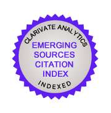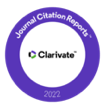Multisensory experiences in Cultural Districts: new methodologies for the study
DOI:
https://doi.org/10.22530/ayc.2023.23.633Keywords:
Bankside, Cultural Disctricts, Atlas Mnemosyne, Multisensory Atlas, five senses, urban revitalization, iconological methodAbstract
In a society where the power of image becomes more and more latent, it is considered necessary to activate and consider the five senses of the human being in order to fully experience a Cultural District. To do this, this research proposes the creation of a Multisensory Atlas as a study methodology to carry out a correct classification of the resources available in Cultural Districts, taking into account the different relationships and connections between them. This Multisensory Atlas has as its starting point the adaptation of Warburg's Atlas Mnemosyne, in addition to the application of Panofksy's iconological method, thus allowing a good interpretation of the collected material to be carried out. Specifically, for this study, different Cultural Districts of the London city are analyzed -Bankside, London Bridge and South Bank-, verifying how the five senses are not only present in the cultural and artistic experiences they offer, but also thanks to their shared leadership has achieved the revitalization of spaces with a strong personality that differentiates them and makes them unique compared to the rest, in addition to becoming authentic models to follow.
References
ACME STUDIOS (2008). Artists in East London. Disponible en www.acme.org.uk/download.php?pdf=149 (última consulta: 20/10/2017).
ALICATA, María (2008). Tate Modern London. Milán: Mondadori Electra.
ARYANDANI, Rima (2012). Cultural tourism and creative cultural district: stakeholder analysis of cultural districts in London South Bank. Switzerland: Università della Svizzera Italiana. Disponible en https://www.academia.edu/3441508/Cultural_tourism_and_creative_cultu-ral_district_stakeholder_analysis_of_cultural_districts_in_London_South_Bank (última consulta: 17 de marzo de 2016).
ARCHIVE JOURNEYS. Tate History. Disponible en http://www2.tate.org.uk/archivejourneys/historyhtml/?_ga=1.134518200.877980059.1458231184 (última consulta: 17 de marzo de 2016).
BAINS, Harman (2011). Industrial (dis)order: responding to a city in decline-perspectives and practices on adaptive reuse for cultural purpose in London (1975-2000). Londres: History of Design MA Royal College of Art / Victo-ria & Albert Museum.
BANKSIDE DESIGN DISTRICT. Disponible en http://banksidedesigndistrict.co.uk/ (última consulta: 17 de marzo de 2016).
BETTER BANKSIDE. Disponible en http://www.betterbankside.co.uk/ (última consulta: 17 de marzo de 2016).
BLAZWICK, Iwona y WILSON, Simon (eds.) (2000). Tate Modern. The handbook. Londres: Tate Publishing.
BOROUGH MARKET. Disponible en http://boroughmarket.org.uk/ (última con-sulta: 30 de marzo de 2016).
BRANDON, David y BROOKE, Alan (2011). Bankside. London’s original district of sin. Great Britain: Amberley.
DOUGLASS, Mike (2015). “Creative communities and the cultural economy – Insadong, chaebol urbanism and the local state in Seoul” en Cities. The In-ternational Journal of Urban Policy and Planning Nº 56, pp. 148-155. Else-vier. Disponible en http://daneshyari.com/article/preview/1008178.pdf (última consulta: 24 de octubre de 2017).
GOLDEN GRACE (1951). Old Bankside. Londres: Williams & Norgate LTD.
GOMBRICH, E. H. (1992). Aby Warburg. Una biografía intelectual. Madrid: Alianza Editorial.
HEWETT, I. (2007). London's South Bank: The walk of life. Disponible en http://www.telegraph.co.uk/culture/film/3667140/Londons-South-Bank-The-walkof-life.html (última consulta: 17 de marzo de 2016).
KIRKALDY TESTING MUSEUM. Disponible en http://www.testingmuseum.org.uk/ (última consulta: 20 de marzo de 2016).
LAZZERETTI (2008). “El Distrito Cultural” en Colección Mediterráneo Económi-co: Los distritos industriales. Nº 13, pp. 327-251. Almería: CAJAMAR Caja Rural. Disponible en http://www.publicacionescajamar.es/pdf/publicaciones-periodicas/mediterraneo-economico/13/13-225.pdf (última consulta: 24 de octubre de 2017).
LONDON DESIGN FESTIVAL. Disponible http://www.londondesignfestival.com/ (última consulta: 17 de marzo de 2016).
MAITLAND, R., NEWMAN, P. (2004). Distinctive places in the reconfiguration of London tourism. Disponible en http://westminsterresearch.wmin.ac.uk/477/1/Maitland_,_Newman_2004_final.pdf (última consulta: 17 de marzo de 2016).
MERGE FESTIVAL. Disponible en http://mergefestival.co.uk/ (última consulta: 17 de marzo de 2016).
OLMOS JUÁREZ, Lourdes y GARCÍA CEBRIÁN, Rafael (2016). Estructura del mer-cado turístico. Madrid: Paraninfo.
PARK, Se Hoon (2016). “Can we implant an artist community? A reflection on government-led cultural districts in Korea” en Cities. The International Journal of Urban Policy and Planning Nº 56, pp. 172-179. Elsevier. Disponi-ble en https://www.sciencedirect.com/science/article/pii/S0264275115001365 (última consulta: 24 de octubre de 2017).
PÉREZ ASPERILLA, Estíbaliz (2017). “Transformando Bankside” en PÉREZ, Elías M.; MARTÍNEZ, Emilio y SILVA DOS SANTOS, Fabiane C. (Eds.). GLO-CAL [codificar, mediar, transformar, vivir]. III Congreso Internacional de In-vestigación en Artes Visuales. Valencia: Universitat Politècnica de València. Pp. 869-875.
–– (2017 b). “Las mujeres-ganso de Crossbones Graveyard”. En Cuestiones de género: de la igualdad y la diferencia, nº 12, pp. 307-324.
POWELL, Kenneth (2004). City Reborn. Architecture and Regeneration in Lon-don, from Bankside to Dulwich. Londres: Merrell.
REILLY, Leonard y MARSHALL, Geoff (2001). The story of Bankside. From the River Thames to St. George’s Circus. Londres: London Borough of Southwark.
RENDLE, William (1878). Old Southwark and its people. London: W. Drewett.
ROBERTS, Howard y GODFREY, Walter H. (1950). Survey of London. Volumen XXII: Bankside (the parishes of St. Saviour and Christchurch Southwark). Londres: London County Council.
SABBAGH, Karl (2000). Power into Art. Creating Tate Modern, Bankside. Lon-dres: Penguin Press.
SOUTHBANK CENTRE. Disponible en http://www.southbankcentre.co.uk/ (úl-tima consulta: 17 de marzo de 2016).
SOUTHBANK London.com. Disponible http://www.southbanklondon.com/ espanol (última consulta: 17 de marzo de 2016).
SPALDING, F. (1998). The Tate. A History. London: Tate Gallery Publishing.
TATE MODERN. Disponible en http://www.tate.org.uk/visit/tate-modern (úl-tima consulta: 1 de abril de 2016).
TATE MODERN. The Building (2012). London: Tate.
THE CLINK PRISON MUSEUM. Disponible en http://www.clink.co.uk/ (última consulta: 20 de marzo de 2016).
VELÁZQUEZ VALORIA, Isabela y VERDAGUER VIANA-CÁRDENAS, Carlos (2011). Regeneración urbana integral. Tres experiencias europeas innovadoras: Île de Nantes, Coin Street y Barrio de la Mina. Madrid: SEPES Entidad Estatal de Suelo.
VISIT BANKSIDE. Disponible en http://www.visitbankside.com/ (última con-sulta: 17 de marzo de 2016).
WARBURG, Aby (2010). Atlas Mnemosyne. Madrid: Ediciones Akal.
WITHERFORD WATSON MANN ARCHITECTS (s.f.). Bankside urban forest. Dispo-nible en https://app.box.com/s/3u2q32kta8l74qn848yt (última consulta: 22 de marzo de 2016).
Downloads
Published
How to Cite
Issue
Section
License
Copyright (c) 2023 ARTE Y CIUDAD. Research Journal

This work is licensed under a Creative Commons Attribution-NonCommercial 4.0 International License.











